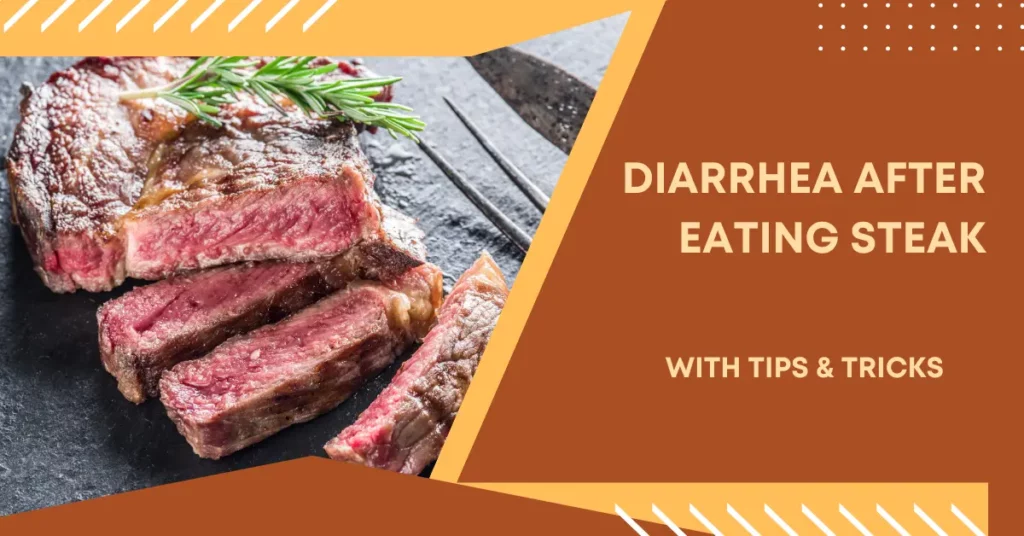This post may contain affiliate links. If you use these links to buy something we may earn a small commission. Thanks.
Eating a perfectly cooked steak is a satisfying experience for many, but for some, it comes with an unexpected downside diarrhea. If you find yourself running to the bathroom after consuming steak, you may be wondering what’s causing this digestive reaction. While occasional digestive upset is normal, frequent diarrhea after eating steak can signal an underlying issue that needs attention.
There are several potential reasons why steak might be causing digestive distress, ranging from food sensitivities to bacterial contamination. Understanding the root cause is crucial in preventing future discomfort and ensuring that you can enjoy your meals without worry.
In this article, we’ll explore the various reasons why steak might trigger diarrhea, how to prevent it, and when you should seek medical advice.
Potential Causes of Diarrhea After Eating Steak
1. Food Sensitivities & Intolerances
Lactose Intolerance (If Steak Is Paired with Dairy)
Many people enjoy steak with rich, creamy sauces like blue cheese, garlic butter, or Alfredo sauce. If you are lactose intolerant, consuming dairy-based products alongside steak could be the culprit behind your digestive issues. Lactose intolerance occurs when the body lacks lactase, the enzyme needed to digest lactose (a sugar found in dairy). This can result in symptoms like bloating, gas, and diarrhea.
Histamine Intolerance
Some aged or processed meats, including dry-aged steak, contain high levels of histamine. If your body struggles to break down histamine due to a deficiency in the enzyme diamine oxidase (DAO), you may experience symptoms such as diarrhea, headaches, or skin rashes.

2. Meat Allergy (Alpha-Gal Syndrome)
Though rare, some people develop an allergy to red meat due to a condition called Alpha-Gal Syndrome. This is caused by a bite from the Lone Star tick, which triggers an immune response to a sugar molecule found in red meat called alpha-gal. Symptoms can appear hours after eating steak and may include diarrhea, nausea, abdominal pain, itching, or even anaphylaxis in severe cases.
3. Foodborne Illness & Contamination
Undercooked or Contaminated Meat
Steak, especially if not cooked to the right internal temperature, can harbor harmful bacteria like:
- E. coli – Commonly found in undercooked beef, causing severe diarrhea, stomach cramps, and vomiting.
- Salmonella – A bacteria that thrives in raw or undercooked meat, leading to food poisoning.
- Campylobacter – Can cause symptoms similar to food poisoning, including diarrhea, fever, and abdominal pain.
Improper food handling, cross-contamination, and consuming steak that has been left out at unsafe temperatures can also increase the risk of bacterial infections.
4. High Fat Content
Steak, especially fattier cuts like ribeye, T-bone, or prime rib, contains a high amount of fat. While fat is an essential part of the diet, consuming too much at once can overwhelm the digestive system.
Bile Overproduction
The body releases bile to help digest fats, but an excess of bile can lead to watery stools or diarrhea. People with gallbladder issues or those who have had their gallbladder removed are more susceptible to this issue.
Digestive Difficulties
If your digestive system struggles to break down fatty foods, steak could trigger diarrhea, bloating, and discomfort.
5. Seasonings & Marinades
Spicy Ingredients
If you enjoy seasoning your steak with hot spices like black pepper, chili powder, or cayenne, your digestive system might be reacting to the heat. Spicy foods can irritate the lining of the stomach and intestines, leading to diarrhea, especially for those with sensitive stomachs.
High Sodium Content
Many steak marinades and seasoning blends contain high levels of sodium, which can draw water into the intestines, resulting in loose stools.
Artificial Additives
Store-bought marinades often contain preservatives, artificial flavors, and MSG, all of which can contribute to digestive distress in sensitive individuals.
6. Gastrointestinal Disorders
If you frequently experience diarrhea after eating steak, it may indicate an underlying gastrointestinal condition.
Irritable Bowel Syndrome (IBS)
People with IBS often have difficulty digesting certain foods, and high-fat or protein-heavy meals can trigger symptoms like diarrhea, bloating, and cramps.
Crohn’s Disease or Ulcerative Colitis
These inflammatory bowel diseases (IBD) can cause the digestive system to react negatively to red meat, leading to frequent diarrhea and abdominal pain.
Celiac Disease
Although steak itself is gluten-free, cross-contamination or eating steak with gluten-containing sauces or seasonings could trigger symptoms in people with celiac disease.
7. Digestive Enzyme Deficiency
Proper digestion of red meat requires stomach acid and specific enzymes. If you have low stomach acid (hypochlorhydria) or a deficiency in digestive enzymes, your body may struggle to break down steak properly, leading to diarrhea, bloating, and discomfort.
How to Prevent Diarrhea After Eating Steak
If you suspect that steak is causing digestive distress, here are some ways to prevent diarrhea:
- Choose Leaner Cuts – Opt for leaner cuts like filet mignon or sirloin instead of fatty cuts like ribeye.
- Cook Steak Thoroughly – Ensure your steak reaches a safe internal temperature to kill bacteria (145°F for medium-rare, 160°F for medium).
- Avoid Excessive Seasonings & Marinades – Stick to simple, natural seasonings like salt, pepper, and fresh herbs.
- Eat Smaller Portions – Large servings of red meat can be hard on digestion, so try eating smaller amounts.
- Check for Food Allergies & Intolerances – If you suspect an allergy, consult an allergist for testing.
- Monitor Other Dietary Triggers – Keep a food diary to track other ingredients that might be contributing to your symptoms.
- Drink Plenty of Water – Staying hydrated helps with digestion and reduces the risk of dehydration from diarrhea.
When to See a Doctor
While occasional diarrhea after eating steak isn’t usually a cause for concern, you should see a doctor if you experience:
- Persistent or severe symptoms lasting more than a few days.
- Blood in your stool (this could indicate a serious condition).
- Unintentional weight loss along with digestive issues.
- Symptoms accompanied by fever, vomiting, or dehydration.
A healthcare provider can perform tests to determine if an underlying condition like an allergy, intolerance, or gastrointestinal disorder is responsible for your symptoms.
Conclusion
If you frequently experience diarrhea after eating steak, it’s important to pinpoint the root cause. Whether it’s due to foodborne illness, a meat allergy, excessive fat intake, or an underlying digestive disorder, understanding what triggers your symptoms is key to preventing discomfort.
By making mindful food choices, cooking steak properly, and seeking medical advice if necessary, you can enjoy your favorite meal without digestive distress. If the problem persists, a healthcare professional can help identify and manage the underlying issue.
Now that you know the possible causes and solutions, you can take steps to prevent post-steak digestive issues and savor your meals with confidence.
